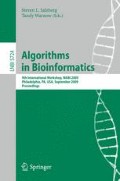Abstract
The breakpoint distance is one of the most straightforward genome comparison measures. Surprisingly, when it comes to define it precisely for multichromosomal genomes with both linear and circular chromosomes, there is more than one way to go about it. In this paper we study Single-Cut-or-Join (SCJ), a breakpoint-like rearrangement event for which we present linear and polynomial time algorithms that solve several genome rearrangement problems, such as median and halving. For the multichromosomal linear genome median problem, this is the first polynomial time algorithm described, since for other breakpoint distances this problem is NP-hard. These new results may be of value as a speedily computable, first approximation to distances or phylogenies based on more realistic rearrangement models.
Access this chapter
Tax calculation will be finalised at checkout
Purchases are for personal use only
Preview
Unable to display preview. Download preview PDF.
References
Sturtevant, A.H., Dobzhansky, T.: Inversions in the third chromosome of wild races of Drosophila pseudoobscura, and their use in the study of the history of the species. PNAS 22(7), 448–450 (1936)
McClintock, B.: The origin and behavior of mutable loci in maize. PNAS 36(6), 344–355 (1950)
Nadeau, J.H., Taylor, B.A.: Lengths of chromosomal segments conserved since divergence of man and mouse. PNAS 81(3), 814–818 (1984)
Hannenhalli, S., Pevzner, P.A.: Transforming cabbage into turnip (polynomial algorithm for sorting signed permutations by reversals). In: Proc. 27th Ann. Symp. Theory of Computing STOC 1995 (1995)
Hannenhalli, S.: Polynomial-time algorithm for computing translocation distance between genomes. Discrete Appl. Math. 71(1-3), 137–151 (1996)
Christie, D.A.: Sorting permutations by block-interchanges. Information Processing Letters 60, 165–169 (1996)
Bafna, V., Pevzner, P.A.: Sorting by transpositions. SIAM J. Discrete Math. 11(2), 224–240 (1998)
Elias, I., Hartman, T.: A 1.375-approximation algorithm for sorting by transpositions. IEEE/ACM Transactions on Computational Biology and Bioinformatics 3(4), 369–379 (2006)
Mira, C., Meidanis, J.: Sorting by block-interchanges and signed reversals. In: Proc. ITNG 2007, pp. 670–676 (2007)
Dias, Z., Meidanis, J.: Genome rearrangements distance by fusion, fission, and transposition is easy. In: Proc. SPIRE 2001, pp. 250–253 (2001)
Lu, C.L., Huang, Y.L., Wang, T.C., Chiu, H.T.: Analysis of circular genome rearrangement by fusions, fissions and block-interchanges. BMC Bioinformatics 7, 295 (2006)
Yancopoulos, S., Attie, O., Friedberg, R.: Efficient sorting of genomic permutations by translocation, inversion and block interchange. Bioinformatics 21(16), 3340–3346 (2005)
Blanchette, M., Bourque, G., Sankoff, D.: Breakpoint phylogenies. In: Genome Inform. Ser. Workshop Genome Inform., vol. 8, pp. 25–34 (1997)
Moret, B.M., Wang, L.S., Warnow, T., Wyman, S.K.: New approaches for reconstructing phylogenies from gene order data. Bioinformatics 17(suppl. 1), S165–S173 (2001)
Bourque, G., Pevzner, P.A.: Genome-scale evolution: reconstructing gene orders in the ancestral species. Genome Res. 12(1), 26–36 (2002)
Adam, Z., Sankoff, D.: The ABCs of MGR with DCJ. Evol. Bioinform. Online 4, 69–74 (2008)
Tannier, E., Zheng, C., Sankoff, D.: Multichromosomal genome median and halving problems. In: Crandall, K.A., Lagergren, J. (eds.) WABI 2008. LNCS (LNBI), vol. 5251, pp. 1–13. Springer, Heidelberg (2008)
Bergeron, A., Mixtacki, J., Stoye, J.: A unifying view of genome rearrangements. In: Bücher, P., Moret, B.M.E. (eds.) WABI 2006. LNCS (LNBI), vol. 4175, pp. 163–173. Springer, Heidelberg (2006)
Bryant, D.: The complexity of the breakpoint median problem. Technical Report CRM-2579, Centre de recherches mathematiques, Université de Montréal (1998)
Caprara, A.: The reversal median problem. INFORMS J. Comput. 15, 93–113 (2003)
Lovász, L., Plummer, M.D.: Matching theory. Annals of Discrete Mathematics, vol. 29. North-Holland, Amsterdam (1986)
Ohno, S.: Evolution by gene duplication. Springer, Heidelberg (1970)
Kellis, M., Birren, B.W., Lander, E.S.: Proof and evolutionary analysis of ancient genome duplication in the yeast saccharomyces cerevisiae. Nature 428(6983), 617–624 (2004)
Alekseyev, M.A., Pevzner, P.A.: Colored de Bruijn graphs and the genome halving problem. IEEE/ACM Trans. Comput. Biol. Bioinform. 4(1), 98–107 (2007)
Mixtacki, J.: Genome halving under DCJ revisited. In: Hu, X., Wang, J. (eds.) COCOON 2008. LNCS, vol. 5092, pp. 276–286. Springer, Heidelberg (2008)
Warren, R., Sankoff, D.: Genome aliquoting with double cut and join. BMC Bioinformatics 10(suppl. 1), S2 (2009)
Zheng, C., Zhu, Q., Adam, Z., Sankoff, D.: Guided genome halving: hardness, heuristics and the history of the hemiascomycetes. Bioinformatics 24(13), i96–i104 (2008)
Author information
Authors and Affiliations
Editor information
Editors and Affiliations
Rights and permissions
Copyright information
© 2009 Springer-Verlag Berlin Heidelberg
About this paper
Cite this paper
Feijão, P., Meidanis, J. (2009). SCJ: A Variant of Breakpoint Distance for Which Sorting, Genome Median and Genome Halving Problems Are Easy. In: Salzberg, S.L., Warnow, T. (eds) Algorithms in Bioinformatics. WABI 2009. Lecture Notes in Computer Science(), vol 5724. Springer, Berlin, Heidelberg. https://doi.org/10.1007/978-3-642-04241-6_8
Download citation
DOI: https://doi.org/10.1007/978-3-642-04241-6_8
Publisher Name: Springer, Berlin, Heidelberg
Print ISBN: 978-3-642-04240-9
Online ISBN: 978-3-642-04241-6
eBook Packages: Computer ScienceComputer Science (R0)

